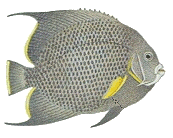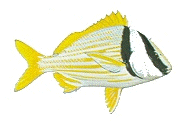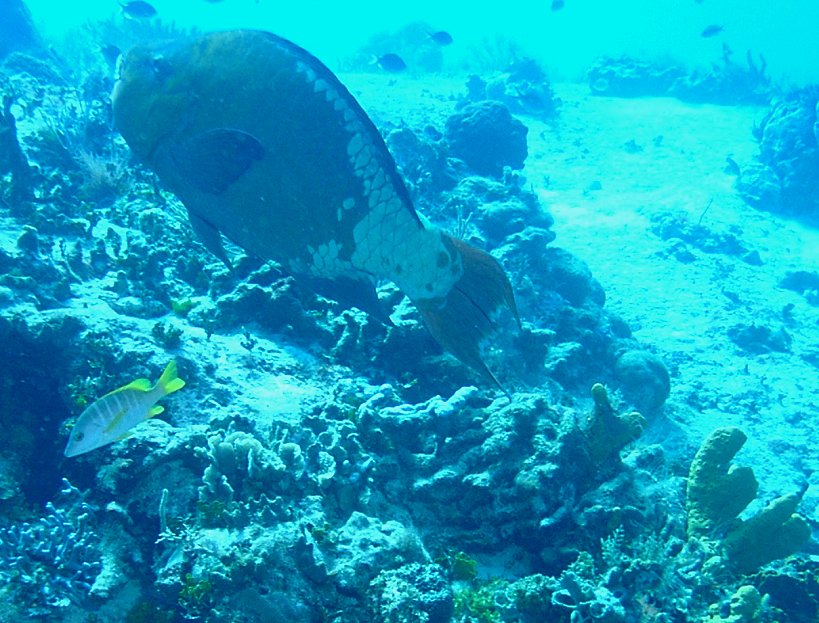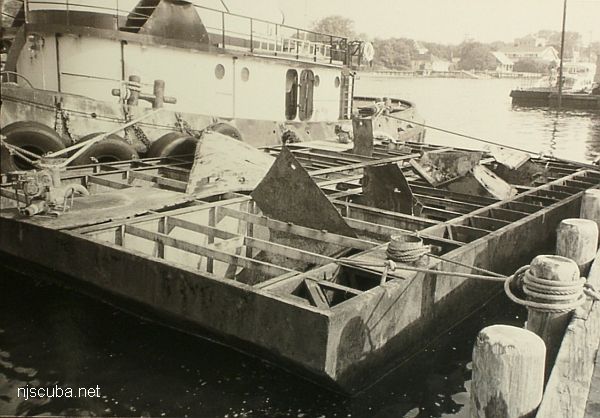Cozumel

This was my very first outing with a digital camera underwater. These are the most interesting of several hundred shots. Beginner's luck.
This trip was a long time ago, but the pictures are nice, and I'm surprised how many people still look at them, so I'll put in the effort and keep these pages alive.
Cozumel Dive Sites

This text is from an old magazine article. The map is a quickie - not very accurate but good enough.
Barracuda Reef is located in the northernmost section of Cozumel. The reef is very beautiful but very tricky to dive, even for advanced divers with strong swimming skills. It is a sheer wall filled with the brightest of colors. The current can be ferocious and may have down-currents running 7 knots. I recommend staying very close to the wall because the current may actually pull you away from the edge, and the breaks in the reef create more possibilities of down-currents. Large pelagics are common. Personal dive equipment should include signaling devices such as whistles and dive sausages.
Cardona is a shallow and low-lying reef with many ledges and overhangs.

Casa del Mar (Airplane Flats) has an easy beach entry sloping gradually to a patch reef at about 15 feet, and then dropping to a narrow strip reef at 35 feet. Marine life is plentiful, and depending upon the season you may encounter large schools of mullet - quite a treat! The remains of a boat house a school of grunts and the occasional moray. The more enterprising might kick out to the wall and drift in to Villablanca beach, catching a taxi to return.
Chankanab is located geographically in the middle of an eddy, which causes a southerly current. Visibility is generally a little poorer and the water a little, colder due to the freshwater runoff from the island. This is unparalleled for photography, and large crabs and lobsters abound in daylight hours. There are lots of harlequin pipefish in the grassy areas, and eagle rays can occasionally be seen sailing gracefully by in the sandy area between this reef and Bolones.

Parrotfish
Bolones of Chankanab literally translated, it is the "balls" or "balloons" of Chankanab, so named for the shape of the reef. Coral heads rise 10 to12 feet from the seafloor in separate islands. Each has its own ecosystem and special characteristics. It is unlike any other reef in Cozumel and a dream-come-true for the wide-angle photographer.
Chankanab Park is a national park and there is an admission fee. Due to traffic this reef has suffered greatly. There is a large statue of Christ, a small statue of the Virgin Guadalupe and remnants of an old boat, home to a large school of grunts. Most interesting is a cavern inhabited by tarpon. A sign warns divers not to go too far in, as it does turn into a cave system. Lights, knives and gloves are not permitted. Excellent for photography.

Angelfish
Colombia Reef sports a series of towering coral columns. The drop-off is steep and it tapers into a sloping, sandy bottom. Large groupers and turtles patrol this reef, which is so large you would have to take it in three separate dives to cover everything. The interior ridge is separated from the outer ridge by a sandy passage. Coral heads and caverns house nurse sharks. As you fly over the sandy areas, watch for garden eels. The current is generally mild here.
Colombia Shallows is probably the longest and most diverse of the shallow reefs with sections and pinnacles coming within a few feet of the surface. Since it's close to Columbia Lagoon, Cozumel's largest natural estuary, it is flanked by mangroves that protect the reefs from silty runoff and serve as a nursery for quantities of Caribbean fish. Look for the bright burgundy vase sponges.

Delila offers rolling plains of coral and gorgonians which flow into a craggy ridge that has schools of hundreds of tangs, grunts and the occasional nurse shark. Generally a fast current.
Dzul Ha is an extraordinarily beautiful place. The long patch reef is easily accessible and teems with fish. From the delicate juvenile spotted drum to the giant super-male rainbow parrotfish, the variety and sheer numbers of fish will astonish you. The current changes constantly so you must be alert, but it is generally mild.

Angelfish
El Paso del Cedral is an area of coral caves housing a remarkable school of glassy sweepers. Surrounding this are overhangs and ledges that shelter large groupers, green and spotted eels, and schooling grunts intermixed with porkfish. Toward the northern end are schooling barracudas. Current can be strong and capricious, and it's not impossible to miss the reef.
Cedral Wall is a remarkable reef that begins at 45 feet and has the structure and location for a strong current. Turtles and eagle rays are frequent here. This reef can be combined with El Paso Del Cedral.
La Francesa This is infrequently dived. It is home to large crabs and nurse sharks and ably defended by carpets of hydroid coral to warn the incautious of their buoyancy skills.

Maricaibo is in two sections, and one is marked by an old anchor rope encrusted with bright-colored sponges and coral. It runs like a cable and can be used as a landmark. Large pelagics may be encountered because there is access to the open sea. Turtles, large southern rays, and blacktip sharks frequent this area. The other section lies in deeper water and should be approached with caution due to Currents and depth. It is a rounded wall that starts at about 120 feet and curves to the contour of the island. It feels like a trip around the globe in outer space, and shark sightings are common. I have personally seen manta rays there - an extremely rare occurrence.

Parrotfish
Palancar Horseshoe is distinctively Horseshoe-shaped. In the center of the curve is the platform which once was the base for the statue of Christ now located in the National Park off Chankanaab, where it had to be removed after Hurricane Gilbert tipped it over. It is flanked by impressive coral forming a dramatic wall.
Palancar Gardens is lush with gorgonians and marine life and is an ideal first-time dive for newcomers to Cozumel. Gentle currents make this a pleasure to explore.

Angelfish
Paraiso (Paradise) is probably the best known of the middle section reefs and the focus of the controversy over the new cruise ship pier which is under construction. It's located directly in front of the marina named Caleta, and we can only hope it will not become Paradise Lost. This strip reef is a veritable smorgasbord of marine life. The midnight parrotfish is common as well as pairs of French and gray angelfish that have become so accustomed to playing in the bubbles exhaled by their visitors. The first section is lobster heaven to between 30 and 40 lobsters who obligingly line up for photos. The first and second strips are separated by a sandy area about 50 yards long and scattered with sponges and gorgonians. To traverse the third section you must angle yourself a little west if the current is flowing north. It is best to dive this reef at odd hours so you can avoid "rush hour."
Playa Corona is a beautiful reef with a magnificent network of interconnecting tunnels filled with large schools of silversides. There is a complex cave system here, so be sure that you can see the exit before you enter a cavern.

Punta Sur With its spectacular appearance and pattern of jagged pinnacles, it is known as the Cathedral. There are four sections separated by a sloping, sandy bottom. The passageways that penetrate these coral edifices are rich with schools of glassy sweepers and startling light beams that penetrate the cracks and fissures. The last section of this striking reef culminates into what is known as the Devil's Throat. The entrance begins at 70 feet and descends into a forked exit at approximately 120 feet that is filled with schooling silversides.
Punta Sur Shallows has a very silty bottom of fine mud similar to that of a cave system. There are huge sea fans and narrow passages between coral heads. This dive features the only elkhorn coral in Cozumel.

Punta Tunich Wall is normally a fast current dive. It features lush vegetation, plenty of finger coral and hydroid coral. Look for turtles in the sandy area toward the beach.
Punta Tunich This reef is famous for its fast current. The wall is very close to the stony outcropping for which it is named (Mayan for "stony point"). Marine life takes refuge from the current in the gullies, and "foxholes" and green morays are common, as are schools of scrawled filefish.
San Francisco Wall is a gently sloping wall that lends itself to photography. It has many "duck-ins" and overhangs. Plenty of lobster and queen angelfish.
San Juan is an advanced dive requiring strong swimming skills as well as attention to depth and direction. Known for swift currents, it is a garden of white flower coral nestled among finger coral. The width of this reef allows side-by-side diving as opposed to the line formation techniques on other reefs. Small craters pock this reef where divers may be fortunate enough to discover turtles and nurse sharks.

Santa Rosa Wall is a classic Caribbean wall located in front of Diamond Resort. Because of its popularity, it is best to dive here at odd hours. This stunning wall features jutting coral heads reminiscent of gargoyles, and it is honeycombed with tunnels. Sponges abound. Look for pompano and schools of horse-eyed jacks as the wall tapers off. Current can be swift and tricky here.
Santa Rosa Shallows An enterprising divemaster can link this reef with El Paso De Cedral and take advantage of its fast current. Many unsuspecting tourists have logged this dive as Paso De Cedral. This is a patch reef, very loosely constructed, with a good variety of marine life.

Tormentos is a magnificently sculpted reef with angular, sloping sections accentuated by spectacular overhangs. One portion is divided by a sandy area that resembles rolling dunes or perhaps a large snowdrift, which is a sight not, to be missed. It is nicknamed "The moonwalk." Toward the shore, in the grassy areas behind the dune, live seahorses. There is an excellent mix of corals and marine life. Current flows quickly.
Villablanca Wall is famous for the size and variety of sponges. It is conveniently close to town and is close enough to the shoreline to dive from the beach for the experienced diver.
Villablanca is directly in front of the Villablanca Hotel and abundant with diverse corals and life. This patch reef is ample for an hour or more of bottom time, and a good place to swim with groups of juvenile spotted drums or discover a rare sea horse-, a feather in any diver's cap. Excellent for macro. There are other places to dive, and one of the great joys of beach diving in Cozumel is exploring new places. Tanks and equipment are available at all of the above sites. Boat traffic is a serious concern, so a dive flag is a must.

Yucab Wall begins slightly deeper than the other wall dives. This narrow ridge of finger coral has a spectacular drop-off with large schools of queen angelfish. It ends abruptly. The current is strong here.
Yucab is a wide strip reef that has patches on both sides. Current is generally calm and the reef is packed with crabs, octopus, and Cozumel's splendid toadfish. Reef triggerfish slip in and out of their shelters and Margate school under the overhangs.
References

Lonely Planet Diving & Snorkeling - Cozumel
George S. Lewbel, Larry R. Martin
Pisces Books, 1998
96 pages, illustrated, color

Peterson's Field Guides - Coral Reefs
Eugene H. Kaplan
Houghton Mifflin, 1982
289 pages, illustrated, color
More than a field guide, also an in-depth guide to coral reef ecology

Peterson's Field Guides - Atlantic Coast Fishes
Robins / Ray / Douglass
Houghton Mifflin, 1986
354 pages, illustrated, color

Peterson's Field Guides - Southwestern and Caribbean Seashores
Eugene H. Kaplan
Houghton Mifflin, 1988
425 pages, illustrated, color

Peterson's Field Guides - Atlantic Seashore
Kenneth L.Gosner
Houghton Mifflin, 1979
330 pages, illustrated, color






